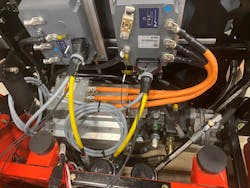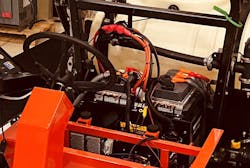Electro-Hydraulic Systems Benefit Electrification of Heavy Machinery
Electrification continues to grow in the heavy-duty mobile equipment industry. Although more common for compact construction equipment and agricultural machinery, among other applications, OEMs are working to expand the size and type of machines in which electrification can be applied.
As such, they are relying on component and system suppliers to aid with their development efforts. Because hydraulics in particular are, and will remain, a vital component of heavy machinery, several companies within the fluid power industry have expanded their development efforts into the electrification space.
Advancements in electrification from the fluid power industry are expected to be a key trend on display at IFPE 2023.
Nott Company (Nott Co.), which specializes in engineered solutions for mobile and industrial fluid power, began working with customers on electrification solutions about 10 years ago. It helps OEMs develop both electro-hydraulic and full-electric systems which will meet their machine and application requirements.
Electro-hydraulic systems bring together electronic and hydraulic components and are seen as a way to help enable the transition to fully electric machines. Not all machine types are capable of using full-electric systems, particularly larger machines, or there are applications where it would not be a convenient option for end-use customers. For those instances in which full-electric systems are not an option or the OEM and its customers are not ready to go fully electric, electro-hydraulic systems provide an alternative in which many of the benefits of electrification can still be achieved.
Power & Motion recently spoke with DJ O’Konek, Engineering Manager at Nott Co., about current electrification trends and how the company is helping customers with the development of electro-hydraulic and full-electric systems.
*Editor's Note: Questions and responses have been edited for clarity.
Power & Motion (P&M): How has Nott Co. seen full-electric and electro-hydraulic system development advance in recent years?
DJ O’Konek (DO): Since Nott Company entered the electrification world about 10 years ago, we’ve seen a lot of changes, especially in the last few years. There's been a lot of heightened interest [from] customers looking for modification of their equipment to electrified solutions, whether that's electro-hydraulic or full-electric systems.
On top of that, there's been a huge influx of mobile hardened products that can help facilitate doing this. When we got going way back when there was not the selection of components that is available today. So, it always made it very, very challenging to just come up with solutions for the customers. The nice thing is, though, the industrial world has been on this path for a really long time so it's just really a transitioning of those components into the mobile hardened world.
The other advantage too, is, as all of these [industries] transition over, components are becoming lower cost and the size of the packages are going down. The other thing we've seen a lot is [movement] towards higher voltages to handle bigger tasks with larger machines.
READ MORE: Bosch Rexroth Launches Range of Electrification Products for Off-Highway Equipment
P&M: Is it mostly emissions regulations that are driving the push towards use of these technologies or are there other drivers Nott Co. is seeing in the market?
DO: It’s [emissions regulations] a factor. I also think that a lot of companies are trying to have a cleaner image. And I think there's just a lot of social awareness [which] is driving it as well. Customers are starting to expect to have those options too.
P&M: What are some of the key factors which should be taken into consideration when developing full-electric and electro-hydraulic systems?
DO: Honestly, the biggest factor whether it’s an electro-hydraulic or full-electric system is efficiency. Everybody is relying on batteries on the vehicles when you're doing this [electrification]. And it's not like you can run down to the gas station to get a can of electrons. So, efficiency becomes key to get the runtime that's required.
Next is really understanding the customer's requirements when it comes to runtime. When you're going through sizing the batteries and everything for the system, that is a huge detail. The other thing is duty cycle. A lot of these machines have existed in the market for a long period of time [and many] of the OEMs don't understand truly what their customers are doing with these machines. Going through [and] analyzing the duty cycle [is important] so that you know where the power is being consumed.
Another thing that a lot of [OEMs] don't think about is [if there is] access to charging [and] what type of charging is available and are their customers going to want an onboard charger or are they going to have access to off-board chargers as well. So, all kinds of little details like that [need to be considered].
P&M: You mentioned keeping efficiency in mind before; what are some ways to go about ensuring efficiency is achieved?
DO: The biggest thing is looking at the components you’re using in your system. As long as you have the budget, going to higher efficiency hydraulic pumps [can help]; making sure that you don't have a bunch of parasitic losses [and] energy being consumed in other areas you weren't expecting. Going through all those details that a lot of people haven't looked at in years.
P&M: Are there any specific use cases or examples you can share for how electro-hydraulic systems are being implemented? What are some of the benefits which can be achieved from utilizing these systems?
DO: We actually have a really good example – we have a customer who did an electro-hydraulic system and a full-electric system on pretty much identical machines. We were able to compare the original hydraulically powered with internal combustion engine [machine] to [one with] an electro-hydraulic system run with a battery and a full-electric system with a battery. In both cases it resulted in an overall reduction in the total cost of ownership.
The downside is there's typically a higher upfront cost tied to that, though, and the reduction is mostly due to maintenance and the cost of charging versus fuel. The full electric, although even more expensive than the electrohydraulic up front, actually decreased the total cost of ownership further due to the reduction of the maintenance by removing the hydraulic system from the vehicle as well.
The other great thing about both versions is we have access to information that we didn't typically have before because a lot of these components come with integrated sensors. [With] that data we can optimize the performance of the machine to get better performance than it historically had as well.
P&M: What would be some of the main components used in these systems?
DO: With the electro-hydraulic system typically we'll have the battery, a primary mover, AC [or] DC motors—that depends on the application—typically close coupled to a hydraulic pump. And then depending on how we're doing that application, it can either be a pressure compensated pump or a fixed displacement pump. From there, it would be all of the traditional components downline of that.
With the full electric, all of that stays the same, except you end up with multiple electric motors distributed across the machine rather than it feeding into the hydraulic pump in the beginning, and then doing all the valving and actuators after that.
P&M: What are some of the key challenges you have seen in the industry, or the company itself experienced, when developing full-electric and electro-hydraulic systems? How can or have these challenges be overcome?
DO: The one thing is finding good suppliers. There's been a huge influx in the market of people providing motors, controllers, different batteries, and teaming up with a good partner, and a partner that has some history and experience, [is beneficial]. With the influx of all these new components, it's getting tougher to find out who you need to partner with to get the results you're looking for.
The other thing is the battery technology and costs themselves; the battery is always the highest driving factor for cost on these vehicles. I've yet to work with a customer on this that hasn't been shocked when they see how much the batteries are going to cost them. Then you have to go through and explain to them the total cost of ownership rather than just looking at the upfront cost. And then you have to teach them well enough to explain that to their customers as well. There’s a lot of learning for every party involved.
P&M: Is Nott Co. trying to help educate the industry in any way? What is the company doing to help overcome that particular challenge?
DO: We’re involved with NFPA on their [electrification] task force going through all of this that can help educate all of their members. We’re involved in several committees with SAE International as well. Nott Co. as a whole is trying to provide the information we have to everybody else out there so this can be an easier transition for them than what we had to go through.
P&M: How have you seen small construction equipment benefit from the use of electrification in its various forms? Will this continue to be the machinery segment in which electrification offers the most benefit?
DO: I think the smaller equipment is easier to transfer over because a lot of people are comfortable with the technology in the smaller [machines] just because there's a lot of consumer products now that are available with that technology on them. But we are seeing a push for larger equipment, as well. I think as time goes on and the controls, the batteries and all that [electrification] technology progresses, we're going to see it being implemented on larger and larger equipment throughout the industry. It's taking longer than some people would like it to but I think it's definitely moving in the right direction.
P&M: Are there specific hurdles that you see to implementing electrification in the larger pieces of equipment? Is it simply the battery size and cost or are there other factors?
DO: There's probably just a handful of really big hurdles, first one is batteries like you're talking about. Because in the larger equipment, you're seeing higher and higher voltages being used, which brings in additional safety constraints and everything like that when you're building up the equipment. Also, just the size; mobile equipment in particular you're limited on how big everything can be to get the job done. So as efficiencies improve and technologies improve, and the power density can be decreased, then you'll see further adoption I believe.
READ MORE: How to Safely Work with High-Voltage Systems
P&M: How do you see the implementation of full-electric and electro-hydraulic systems continuing to progress in the coming years?
DO: I personally see electrification is going to be where everybody's trying to get to. Electro-hydraulic is kind of an interim step, mostly because it's a lower cost entry point and the customers are more comfortable with it. They've been around these hydraulic systems for very long periods of time. They're comfortable with the technology, they know how to maintain it, they know what it should feel like and sound like. But I think everybody's long-term goal is to get to full electric because of the large efficiency gains, [enabling] more runtime with a lower battery cost.
About the Author
Sara Jensen
Executive Editor, Power & Motion
Sara Jensen is executive editor of Power & Motion, directing expanded coverage into the modern fluid power space, as well as mechatronic and smart technologies. She has over 15 years of publishing experience. Prior to Power & Motion she spent 11 years with a trade publication for engineers of heavy-duty equipment, the last 3 of which were as the editor and brand lead. Over the course of her time in the B2B industry, Sara has gained an extensive knowledge of various heavy-duty equipment industries — including construction, agriculture, mining and on-road trucks —along with the systems and market trends which impact them such as fluid power and electronic motion control technologies.
You can follow Sara and Power & Motion via the following social media handles:
X (formerly Twitter): @TechnlgyEditor and @PowerMotionTech
LinkedIn: @SaraJensen and @Power&Motion
Facebook: @PowerMotionTech

Leaders relevant to this article:



